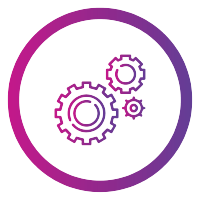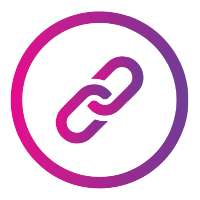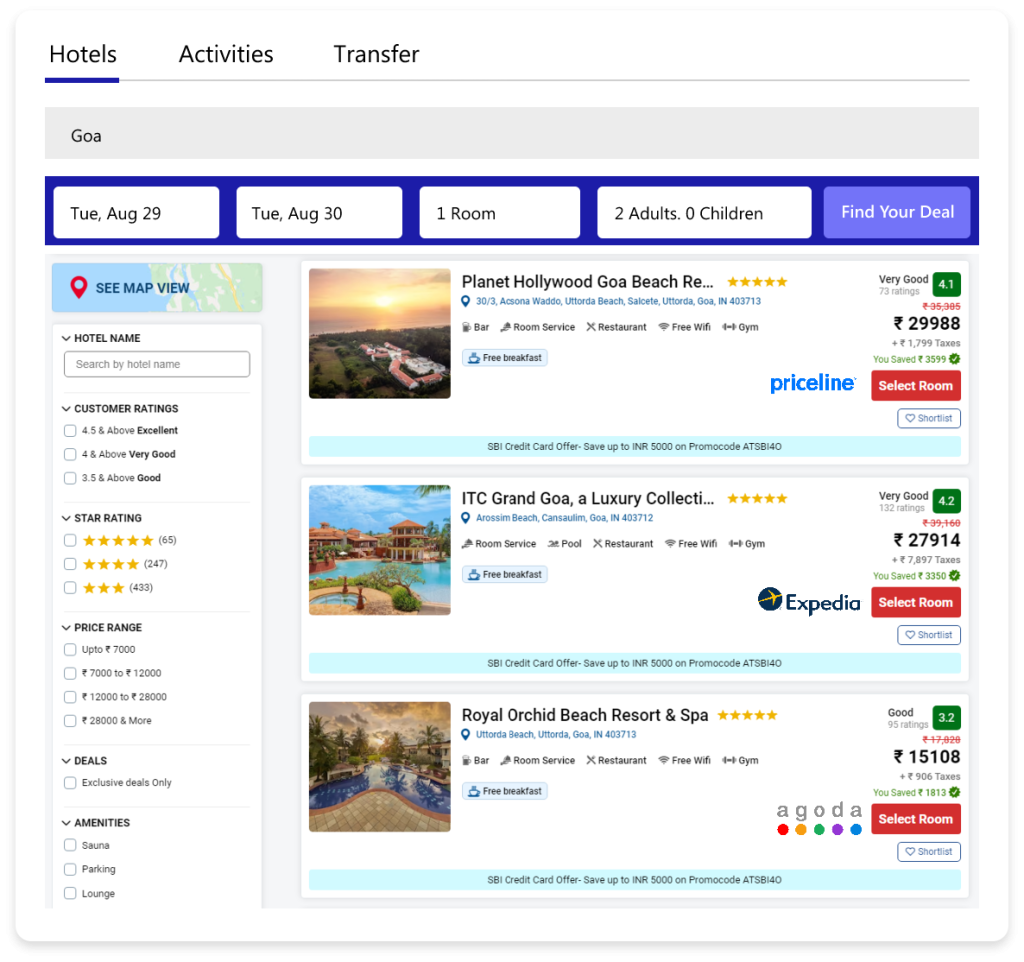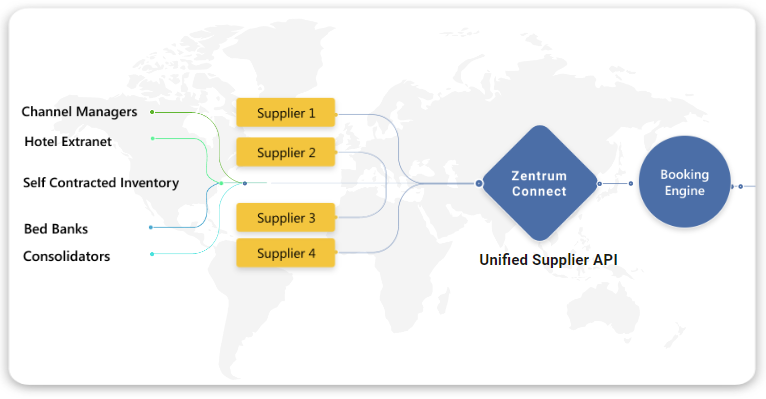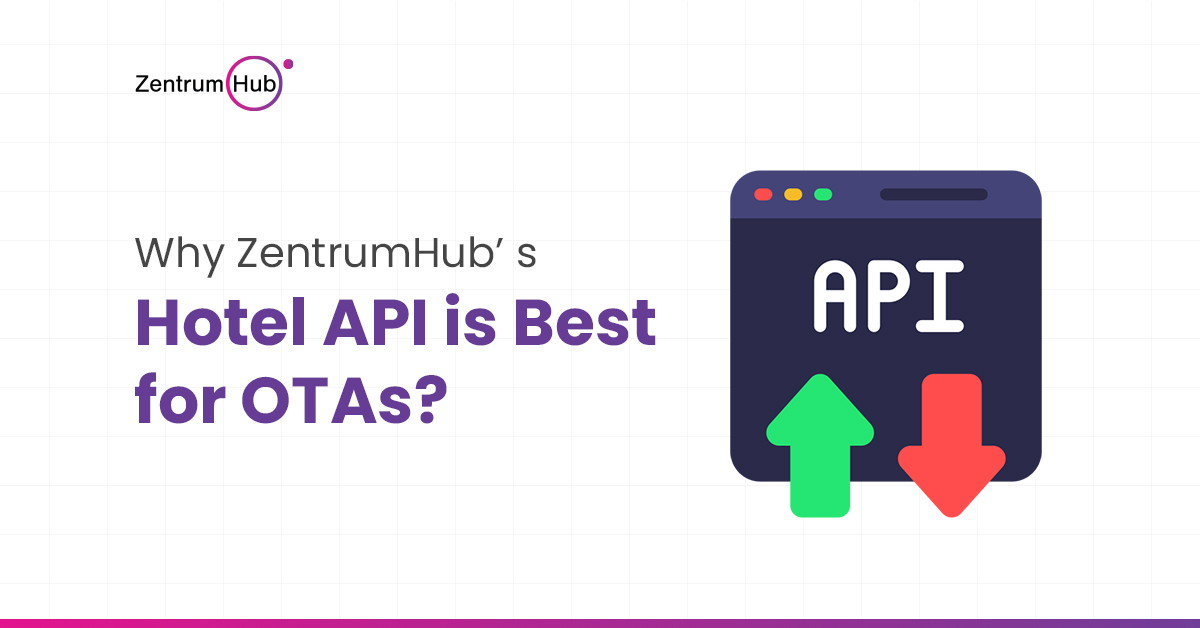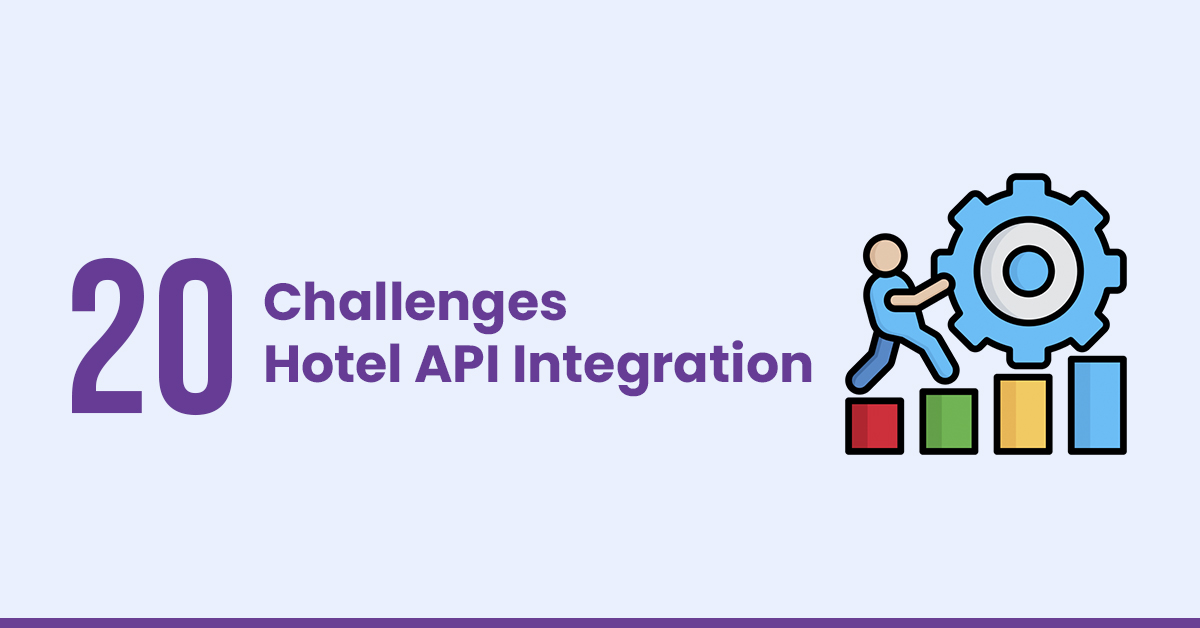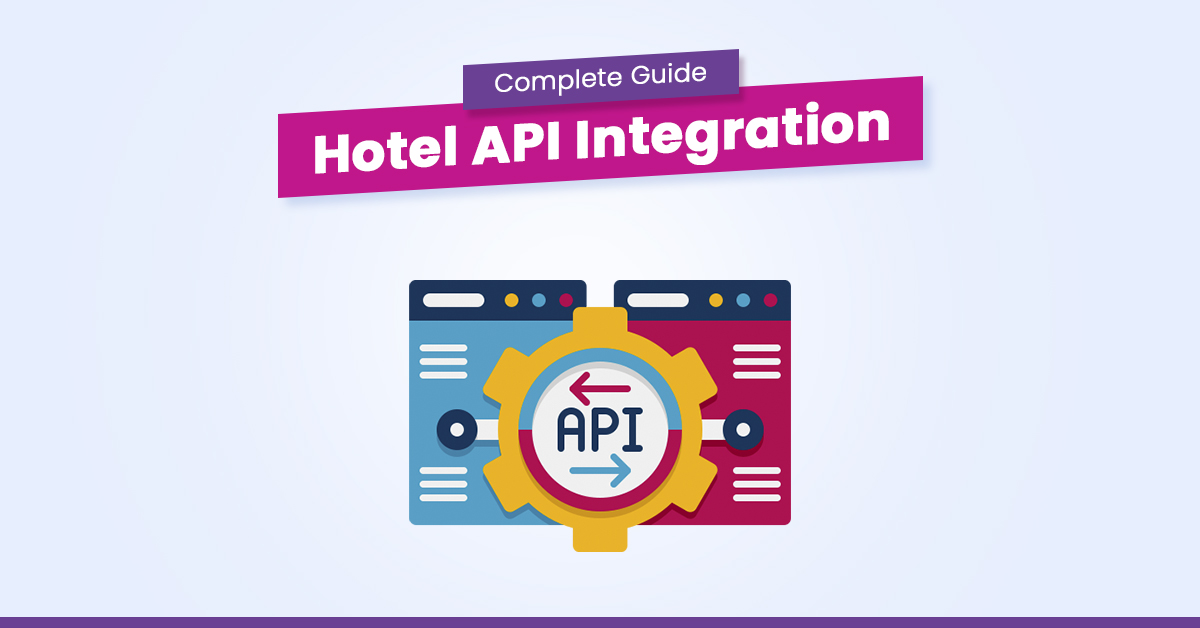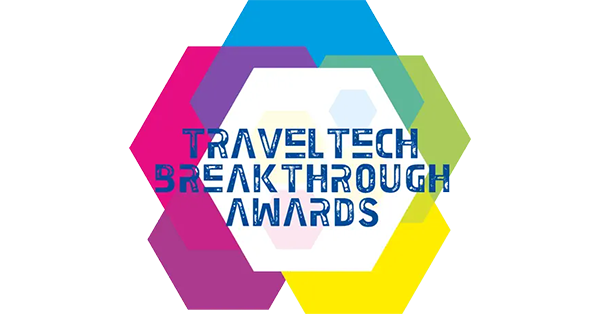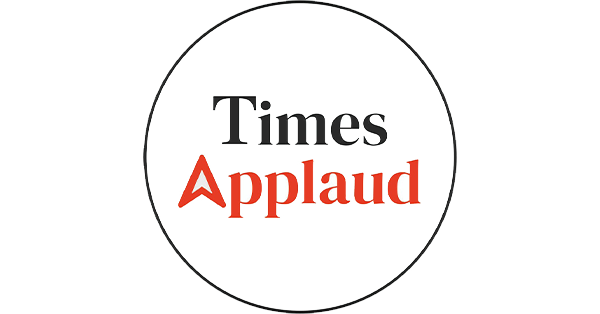Challenges in Hotel API Integration and How to Overcome Them

Challenges in Hotel API Integration and How to Overcome Them Overview Challenges & Solutions in Hotel API Integration Conclusion As the hotel industry becomes increasingly reliant on technology, API integrations have emerged as a cornerstone for seamless operations, particularly in managing bookings, pricing, and availability. Despite their significance, hotel API integration presents unique challenges. Addressing these obstacles is crucial for improving efficiency, guest satisfaction, and revenue. Let’s explore some of the most common challenges in hotel API integration and effective strategies to overcome them. Challenges & Solutions in Hotel API Integration 1. Data Synchronization Issues One of the common API issues in hotel operations is data synchronization across different platforms. Hotels rely on real-time data to manage room availability, pricing, and guest bookings. However, when APIs are not properly synced, this can lead to inconsistent information across the booking platforms, resulting in overbookings, pricing discrepancies, and a loss of trust from guests. How to Overcome: Real-time updates: Implement APIs that push real-time updates rather than periodic syncing. Error monitoring systems: Set up automated monitoring to detect synchronization issues immediately, ensuring faster resolution. Caching strategies: Use effective caching mechanisms to ensure data consistency, especially during peak booking periods. 2. Compatibility with Legacy Systems A significant hotel supplier integration problem is ensuring API compatibility with the hotel’s existing software infrastructure. Many hotels still operate on legacy systems that were not designed to integrate with modern APIs. This can create bottlenecks, especially when dealing with third-party services like OTAs (Online Travel Agencies). How to Overcome: Middleware solutions: Implement middleware that acts as a bridge between legacy systems and modern APIs, ensuring smooth data flow without needing to overhaul the entire system. Custom API development: If necessary, invest in custom APIs tailored to the specific architecture of older systems, making integration more seamless. 3. Inconsistent Data Formats Different hotel suppliers and OTAs often use varied data formats, which complicates integration. This inconsistency makes it difficult for systems to interpret information correctly, such as room rates, descriptions, or availability status, leading to errors. How to Overcome: Data standardization: Develop systems that can convert various data formats into a standardized one for your hotel’s internal system. Schema validation: Incorporate schema validation tools to ensure that incoming data is correctly formatted before it’s processed. 4. Security and Privacy Concerns APIs handle a significant amount of sensitive guest data, such as payment details and personal identification. Security breaches can not only lead to revenue loss but also damage the hotel’s reputation. One of the key challenges in hotel API integration is ensuring that the data exchanged between systems is secure. How to Overcome: Encryption protocols: Use end-to-end encryption for all data transmitted via APIs to prevent unauthorized access. Regular security audits: Conduct frequent security audits and vulnerability testing to identify potential security gaps in the API infrastructure. Compliance with standards: Ensure that APIs comply with global data security standards like PCI-DSS for payment information and GDPR for guest privacy. 5. Rate Parity and Pricing Accuracy Hotels often face challenges ensuring that their pricing stays consistent across multiple booking platforms. API integration issues can lead to delays or inaccuracies in rate updates, causing discrepancies that affect the hotel’s rate parity agreements with OTAs. How to Overcome: Automated rate management: Implement dynamic pricing algorithms through APIs that automatically adjust rates based on demand, ensuring uniformity across all platforms. Frequent data refreshes: Ensure frequent data refresh cycles to minimize the lag between rate updates across systems. 6. Scalability Issues As hotels grow or partner with more suppliers and OTAs, the complexity of managing multiple APIs increases. The system may struggle to keep up with demand, leading to slower response times and integration failures. How to Overcome: Modular architecture: Adopt a modular system design that allows you to scale integrations without affecting overall performance. Load balancing: Use load balancers to distribute traffic evenly across APIs, preventing system overload and ensuring faster response times during peak periods. Cloud-based APIs: Opt for cloud-based solutions that offer scalable infrastructure to handle increasing traffic without compromising on speed or efficiency. 7. Lack of Support and Documentation Poorly documented APIs can make integration a nightmare for development teams, resulting in delays or improperly functioning connections. This is especially true for third-party APIs from suppliers who may not provide sufficient support. How to Overcome: Vendor collaboration: Ensure close collaboration with API vendors and suppliers to gain access to detailed documentation and quick support when needed. API testing environments: Make use of sandbox environments provided by API vendors to test integrations before they go live. 8. Frequent API Changes APIs are often updated by vendors, and while updates can offer enhanced features or performance, they may also break existing integrations. Handling these common API issues requires proactive planning. How to Overcome: Version control: Ensure that you are using versioned APIs, which allow your system to continue functioning on older versions while new updates are being integrated. Monitoring updates: Keep track of scheduled API changes and updates by vendors and plan your development roadmap to accommodate these changes in advance. Want to Learn More? Check Out These Hotel API Blogs Travel API Comparison: 8 Factors for Selecting the Best One Why Do OTAs Need Travel API? Travel APIs: The Cost of Integration for OTAs Travel API Integration: Types, Pricing, Benefits & Timeline How Can Startups and OTAs Maximize Revenue with Hotel Booking APIs? How to Optimize Your Platform with Hotel API Integration? Complete Guide to Hotel API Integration: Costs, Benefits, Technical Challenges in Hotel API Integration and How to Overcome Them How to Choose the Best Hotel API Provider? Key Features to Evaluate Hotel API Integration Costs: Pricing Methods for OTAs Explained What is the Difference Between B2C and B2B Hotel Booking API? Role of Hotel Booking APIs in Hotel Booking Engine? Conclusion By addressing these hotel supplier integration problems through real-time updates, data standardization, security measures, and scalable solutions, hotels can unlock more efficient operations and enhance the guest experience. The key to overcoming these challenges in hotel
Role of AI in the Hospitality Industry: 2024 Trends
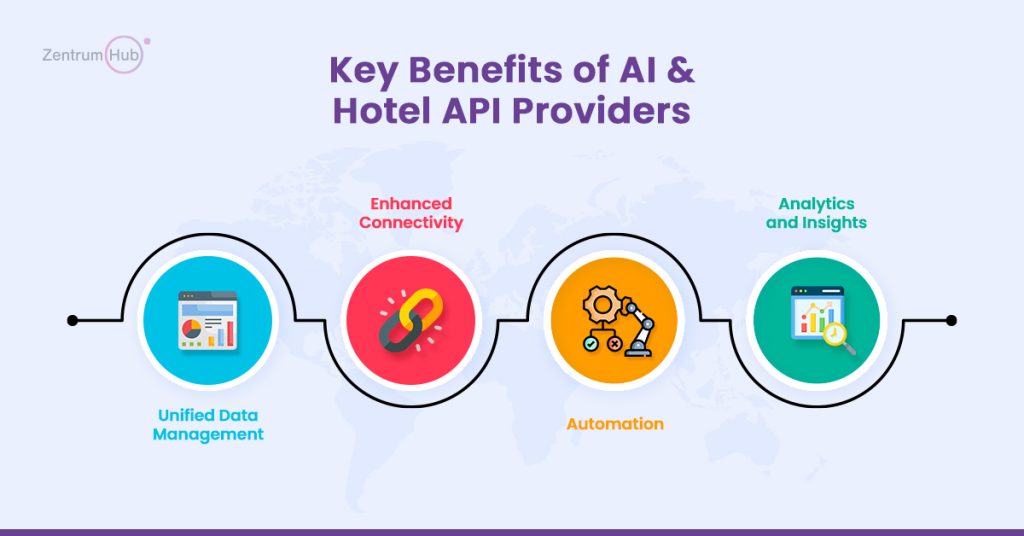
The Role of AI in the Hospitality Industry: 2024 Trends Overview AI-Powered Hotel Booking Engines Enhancing Guest Experiences with AI Chatbots and Virtual Assistants Streamlining Operations with AI & Hotel API Providers AI-Driven Revenue Management & Predictive Analytics The Future of AI in Hospitality: What to Expect in 2024 Conclusion Artificial Intelligence (AI) continues to revolutionize industries worldwide, and the hospitality sector is no exception. As we move into 2024, the integration of AI technologies in hotels and travel services is reshaping how customers experience their stay, book accommodations, and interact with brands. Whether it’s improving efficiency through a hotel booking engine or providing robust connectivity with a hotel API provider, AI is setting the stage for a smarter, more efficient future in hospitality. In this blog, we’ll explore the top ways AI is transforming the hospitality industry in 2024 and the key technologies driving this change. AI-Powered Hotel Booking Engines One of the most significant applications of AI in hospitality is the AI-powered hotel booking engine. These systems are no longer just basic tools for making reservations; they have evolved into intelligent systems that personalize the booking experience for each guest. Here’s how AI enhances hotel booking engines: Personalized Recommendations: AI analyzes customer preferences, browsing history, and even social media activity to recommend rooms and services that match individual preferences. Dynamic Pricing: Based on real-time demand, competitors’ rates, and guest behavior, AI-powered booking engines adjust prices dynamically, ensuring hotels remain competitive while maximizing revenue. Voice-Activated Bookings: Many booking engines now incorporate voice recognition, enabling guests to book rooms using virtual assistants like Siri or Alexa. This not only simplifies the process but also caters to a tech-savvy customer base. AI has made the hotel booking process faster, more accurate, and incredibly personalized. Guests can now find their ideal accommodations with just a few clicks, thanks to the advanced capabilities of AI-driven hotel booking engines. Enhancing Guest Experience with AI Chatbots and Virtual Assistants Customer service has always been crucial in the hospitality industry. AI has significantly improved this aspect through chatbots and virtual assistants. Hotels now deploy AI-driven chatbots on their websites and booking platforms to provide 24/7 customer support. These bots handle everything from answering common questions to processing bookings, offering personalized assistance to guests in real time. Key benefits include: Instant Customer Support: Guests can get immediate answers to questions, whether about room availability, amenities, or booking policies. Multilingual Support: AI chatbots can communicate in multiple languages, breaking down language barriers and expanding a hotel’s global reach. Upselling Services: These intelligent systems can upsell room upgrades, spa packages, and other hotel services based on the guest’s preferences and history. Virtual assistants in hotel rooms are also becoming increasingly popular, allowing guests to control the room environment, order room service, or request assistance via voice commands. Streamlining Operations with AI and Hotel API Providers Behind the scenes, AI is making hotel management more efficient through hotel API providers. These providers offer smoothintegration of various systems like property management, customer relationship management (CRM), and booking platforms. AI optimizes operations, reduces manual work, and improves data accuracy across all systems. Benefits of AI and Hotel API Providers: Unified Data Management: Hotel API providers centralize all the data, allowing hotels to manage bookings, guest preferences, and operations from a single platform. Enhanced Connectivity: APIs create a bridge between a hotel’s booking engine, payment systems, and other third-party services, ensuring smooth data flow and real-time updates. Automation: AI-powered automation reduces manual interventions, such as updating inventory or processing payments, saving time and minimizing errors. Analytics and Insights: With real-time data collection, AI provides actionable insights into guest behavior, market trends, and operational inefficiencies, allowing hoteliers to make more informed decisions. Incorporating AI in hotel APIs ensures that all systems work in harmony, offering both guests and hotel staff an effective and efficient experience. AI-Driven Revenue Management and Predictive Analytics Revenue management is a critical function in the hospitality industry, and AI is helping hotels make smarter decisions. By analyzing historical data, current market trends, and even external factors like weather and events, AI can predict demand more accurately and adjust prices accordingly. Key advantages of AI in revenue management: Dynamic Pricing Models: AI adjusts pricing in real-time based on a variety of factors, ensuring optimal room rates that maximize occupancy and revenue. Occupancy Forecasting: Hotels can predict occupancy rates more accurately, helping them plan for peak seasons or low-demand periods. Inventory Management: AI helps optimize room availability by predicting cancellations or no-shows, allowing hotels to overbook smartly without risking guest dissatisfaction. The integration of AI into revenue management systems, often through a hotel booking engine or hotel API provider, ensures that pricing strategies are as fluid and responsive as market conditions. The Future of AI in Hospitality: What to Expect in 2024 As we progress through 2024, AI adoption in the hospitality industry is set to expand even further. Here are some key trends to watch for: Hyper-Personalization: AI will become even more adept at delivering personalized experiences, from tailored room preferences to unique in-stay suggestions based on guest data. Robotic Assistance: We’re seeing the rise of robots handling tasks like room service delivery or cleaning. As AI improves, these robots will become more autonomous and efficient, reducing the need for human intervention in routine tasks. Augmented Reality (AR) and AI Collaboration: AI, combined with AR, could soon allow guests to take virtual tours of hotels before booking, visualize room configurations, or even try out different furniture layouts during their stay. Sustainability-Focused AI Solutions: AI can play a significant role in helping hotels become more eco-friendly by optimizing energy use, managing waste, and even suggesting sustainable options for guests. Conclusion The hospitality industry in 2024 is set to undergo a major transformation with the increased adoption of AI technologies. From enhancing the booking process with advanced hotel booking engines to improving operations through hotel API providers, AI is poised to redefine guest experiences and operational efficiency. As AI continues
Hotel API Integration Costs: Pricing Methods for OTAs Explained
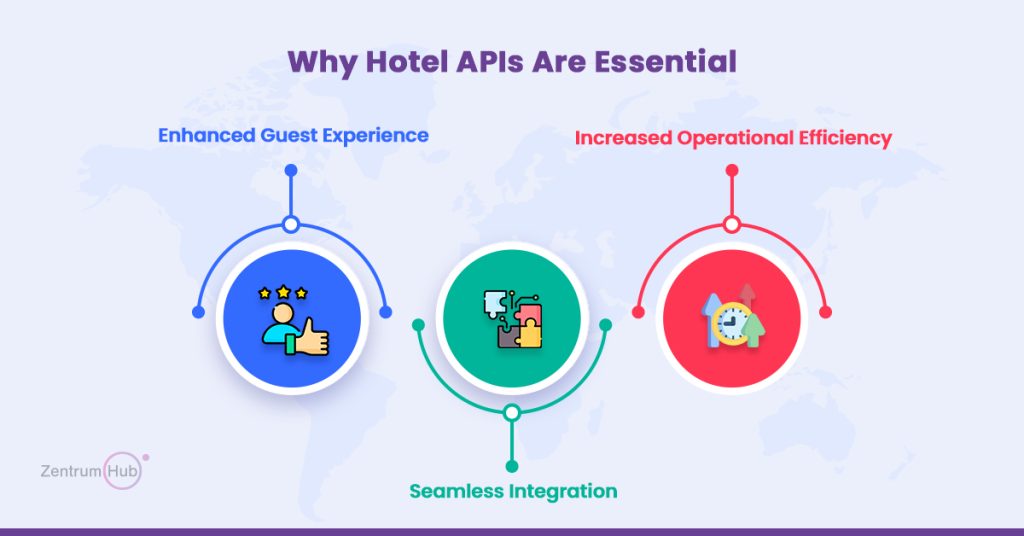
Hotel API Integration Costs: Pricing Methods for OTAs Explained Overview Why Hotel APIs are Essential? Choosing the Right Pricing Model Conclusion When it comes to integrating a hotel API into your operations, pricing is often the first concern. The cost of a hotel API can vary significantly based on your business model, size, and usage patterns. Unlike a one-size-fits-all solution, hotel API pricing is usually offered in three main models: subscription plans, pay-per-use, and custom pricing. Each option has its own benefits and drawbacks, and the right one for you depends on the specific needs of your property. Let’s break down these pricing models to give you a clear understanding of how each works and what you can expect. Why Hotel APIs Are Essential? Before diving into the pricing models, it’s important to understand why hotel APIs are so critical for today’s hotels. Here’s what they do: Seamless Integration: APIs act as a bridge, allowing your hotel’s software systems to communicate and share data, such as guest information, room availability, and rates. Enhanced Guest Experience: Through APIs, hotels can offer more personalized and efficient services, like real-time booking confirmations, customized guest offers, and automated check-ins. Increased Operational Efficiency: APIs reduce manual errors and speed up processes, enabling staff to focus on guest services rather than administrative tasks. With these benefits in mind, let’s move on to the different pricing models you’re likely to encounter. Subscription Plans Overview Subscription-based pricing is one of the most popular models for hotel APIs. Typically, providers charge a monthly or annual fee, offering a fixed set of features or usage limits. This model provides predictability in budgeting, as you pay a set amount regardless of usage. Who It’s Best For Subscription plans are ideal for hotels with steady API usage, where a predictable number of transactions or data calls occur each month. Larger hotels or hotel chains with consistent demand for connectivity between systems often prefer this pricing structure. Key Features Flat-rate billing: A fixed cost is billed at regular intervals. Tiered pricing: Some providers offer multiple subscription tiers with different features or limits, allowing businesses to scale up as their needs grow. All-inclusive packages: Features such as 24/7 support, higher transaction limits, or additional API services are often bundled into premium subscription plans. Pros Predictable costs make financial planning easier. Scalability: You can upgrade to higher tiers as your needs evolve. All-in-one access: Often includes more features than pay-per-use options. Cons Overpaying for underuse: If your API usage is lower than expected, you could end up paying for unused capacity. Limited flexibility: You may have to pay for features you don’t need. Pay-Per-Use (Usage-Based Pricing) Overview In a pay-per-use pricing model, you are charged based on the number of API calls, data transactions, or interactions. This model is performance-driven, with costs fluctuating depending on actual use. It’s similar to how some utilities (like water or electricity) are billed—use more, pay more. Who It’s Best For This pricing model is perfect for hotels with variable usage patterns. If your hotel has seasonal spikes in occupancy or uses the API only for specific functions (such as during promotions or events), pay-per-use can help minimize costs during off-peak times. Key Features Per-call charges: Each API request or data call is individually priced, meaning your costs align directly with your usage. No base fees: You only pay when you use the API, which can be a significant benefit for smaller properties or seasonal operations. Scalable costs: As your needs increase, your costs will too, making this model highly scalable. Pros Cost-efficiency for low usage: If you don’t use the API frequently, you won’t have to worry about high monthly fees. Flexible scaling: You only pay for what you need, making it easy to manage costs as your business grows. Cons Unpredictable expenses: If your usage spikes unexpectedly, so will your costs. No bundling: Extra features or customer support might not be included, leading to additional fees for these services. Custom Pricing Overview For larger hotel chains, groups with specific requirements, or boutique properties needing unique integrations, custom pricing is often the best option. This model allows hoteliers to negotiate a tailored package that aligns with their operational goals, user volume, and feature set. Who It’s Best For Custom pricing is ideal for businesses with complex needs, such as large hotel chains that require deep integration between multiple systems (PMS, CRS, revenue management, etc.). This model is also suited for boutique hotels or properties that need specialized solutions not covered by traditional plans. Key Features Tailored to specific needs: Hotels can work directly with API providers to craft a plan that fits their requirements. Custom integrations: This often includes bespoke features or API endpoints designed specifically for the hotel’s operations. Volume-based discounts: Larger hotels may benefit from reduced per-transaction costs due to the sheer volume of API calls they generate. Pros Highly flexible: Custom plans are designed around your exact requirements, ensuring you’re not paying for features you don’t need. Personalized support: Larger clients typically receive dedicated support teams and service-level agreements (SLAs) to ensure smooth operations. Cons Negotiation-heavy: Getting the right pricing can take time and effort, with multiple rounds of discussions often needed. Higher upfront costs: Custom solutions are usually more expensive upfront, especially if they require complex integrations or additional development. Choosing the Right Pricing Model Selecting the right hotel API provider and pricing model depends on several factors: Size of your hotel: Larger hotels or chains with consistent traffic might find subscription plans more predictable, while smaller or seasonal properties may benefit from pay-per-use models. Usage variability: If your API needs to fluctuate dramatically over the year, pay-per-use is likely your best option. Customization needs: If your property has unique needs or complex software systems, a custom pricing package may offer the best value. Budget predictability: Subscription models provide budget certainty, while pay-per-use introduces cost flexibility with some unpredictability. Want to Learn More? Check Out These Hotel API Blogs Travel API Comparison: 8 Factors for Selecting the Best
How to Choose the Best Hotel API Provider? Key Features to Evaluate
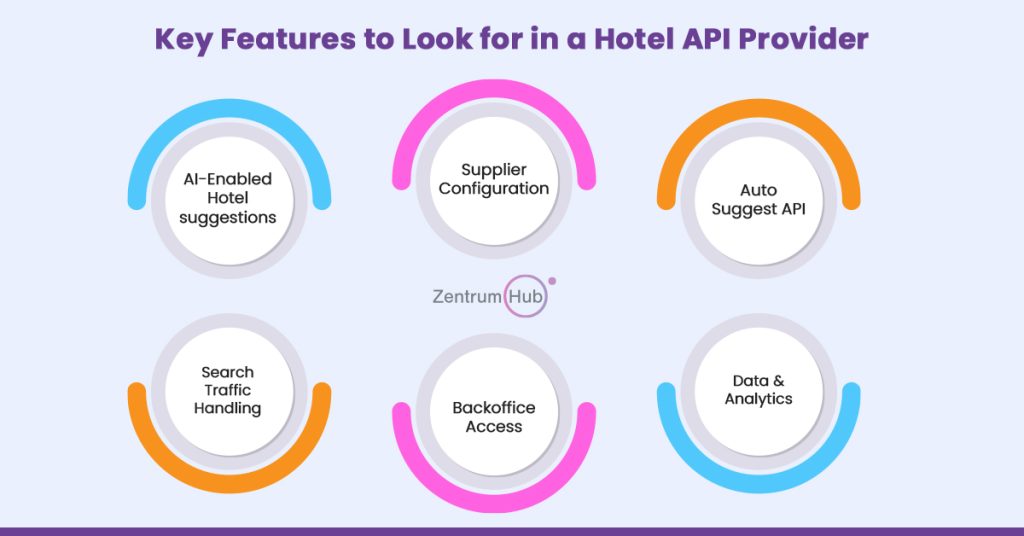
How to Choose the Best Hotel API Provider? Key Features to Evaluate Overview What are Hotel APIs? What are Key Features you should look for in a Hotel API Provider? How API Performance and Speed works? Cost and Pricing Models Customization and Special Features Future Trends in Hotel APIs Conclusion The travel industry has undergone a remarkable transformation over the past decade, with technology driving this evolution at an unprecedented pace. The rise of digital platforms has not only made travel more accessible but has also reshaped how businesses operate within the industry. At the heart of this transformation are APIs—Application Programming Interfaces—that enable seamless communication between different software systems. For businesses in the travel sector, choosing the right hotel API provider is not just a technical decision but a strategic one. The right API can empower a company to offer a wider range of services, enhance user experience, and improve operational efficiency. In an industry where competition is fierce and customer expectations are high, having a robust API that delivers reliable, fast, and secure connections to hotels and other service providers is crucial. Whether you’re an OTA (Online Travel Agency), a travel management company, or a startup looking to disrupt the market, your choice of hotel API provider can make or break your success. This blog will delve into the key features you should look for when evaluating hotel API providers, ensuring that your business is well-equipped to meet the demands of the modern travel landscape. What are Hotel APIs? Hotel APIs are the backbone of modern travel platforms, facilitating connectivity between hotels, OTAs, travel agencies, and other platforms. By allowing these different entities to communicate and exchange information, APIs enable everything from real-time booking and availability checks to pricing updates and personalized recommendations. The Hotel Booking API is perhaps the most critical API for any travel platform. It enables users to search for and book hotel rooms in real-time. This API connects to various hotel databases and returns information on available rooms, prices, and other details needed to complete a booking. It’s vital for ensuring that customers have access to up-to-date information, which is crucial for converting searches into bookings. APIs are integral to the functioning of any travel platform, making it easier for businesses to manage their inventory, pricing, and customer interactions. As such, selecting a hotel API provider that excels in these areas is vital for achieving business success. What are Key Features you should look for in a Hotel API Provider? When evaluating hotel API providers, several key features can significantly impact your business’s ability to deliver exceptional service and maintain a competitive edge. Channel Configuration: The ability to manage multiple distribution channels efficiently is crucial for any travel platform. A good hotel API provider should offer robust channel configuration options, allowing you to connect with numerous OTAs, direct booking channels, and other distribution networks seamlessly. This flexibility ensures that you can maximize your reach and revenue by connecting with the right markets at the right times. Revenue Management Configuration: Dynamic pricing is essential in the travel industry, where demand fluctuates rapidly. Look for API providers that offer advanced revenue management features. These should include tools for implementing dynamic pricing strategies based on various parameters like occupancy rates, competitor pricing, and booking patterns. The ability to configure these settings through the API can give you a significant advantage in maximizing revenue. AI-Enabled Hotel Recommendation: Artificial intelligence is becoming increasingly important in the travel industry. A hotel API provider that incorporates AI-driven recommendations can help enhance user experience by offering personalized suggestions based on past behavior, preferences, and other data points. This feature can lead to higher conversion rates and customer satisfaction by providing users with options that are most relevant to their needs. Supplier Configuration: The ability to manage and configure various suppliers is another critical feature. Your API provider should offer tools to easily integrate and manage different hotel suppliers, ensuring that you have access to a broad range of inventory. This flexibility allows you to cater to diverse customer needs and preferences. Auto Suggest API: User experience is paramount in the travel industry, and features like auto-suggest can significantly enhance this experience. An Auto Suggest API helps users quickly find the hotels, locations, or services they are looking for by providing smart suggestions as they type. This not only speeds up the search process but also helps in guiding users toward completing their bookings. Multi-Currency Support: In today’s globalized world, multi-currency support is a must-have feature for any hotel API provider. This feature allows customers to view prices and make payments in their preferred currency, thereby enhancing their experience and increasing the likelihood of conversion. Additionally, it simplifies the management of international transactions for your business. Search Traffic Handling: Handling high volumes of search traffic is another critical capability to look for in a hotel API provider. During peak travel seasons or promotional campaigns, your platform may experience a surge in search queries. The API should be able to manage this traffic efficiently without causing slowdowns or crashes. Access to All Logs & Booking Logs: Transparency is essential for managing your business effectively. A reliable API provider should offer access to all logs, including booking logs, allowing you to track every transaction and interaction that occurs through the API. This feature is crucial for troubleshooting, monitoring performance, and gaining insights into user behavior. Data & Analytics: Data is the new currency in today’s digital world, and having access to robust analytics tools through your API provider can help you make informed business decisions. Look for providers that offer comprehensive data and analytics features, allowing you to track performance, understand customer behavior, and optimize your offerings. Backoffice Access: Finally, having back-office access through the API provider is essential for managing your operations efficiently. This feature allows your team to manage bookings, view reports, and make necessary adjustments from a centralized location, streamlining your workflow and improving overall efficiency. Read also Travel APIs:
How Payment Fraud Occurs in the Hotel Industry?
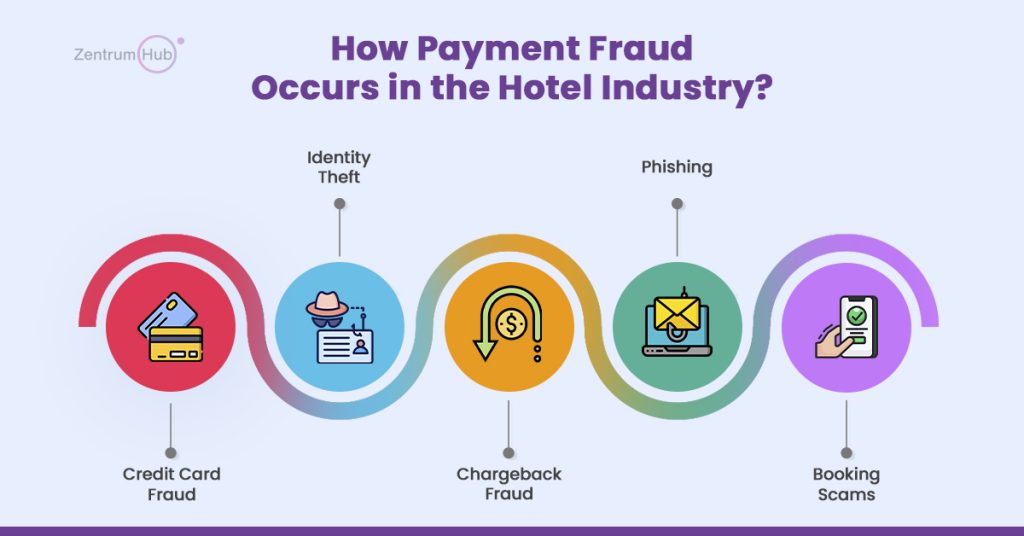
How Payment Fraud Occurs in the Hotel Industry? Overview How Payment Fraud Occurs in the Hotel Industry? Preventive Measures You Can Take How Stripe Radar Detects Payment Fraud? ZentrumHub’s Implementation of Stripe for Fraud Protection In today’s interconnected world, the hotel industry faces significant challenges in safeguarding against payment fraud, a pervasive threat that can result in financial loss and reputational damage. Understanding how fraud occurs and implementing effective preventive measures is crucial for maintaining trust and security in transactions. How Payment Fraud Occurs in the Hotel Industry? Payment fraud in the hotel industry can take various forms, each exploiting vulnerabilities in payment processes and guest information handling: Credit Card Fraud: This involves the unauthorized use of stolen credit card information to book rooms or services. Fraudsters may use compromised card details to make reservations either online or over the phone, often targeting high-value bookings or luxury services. Identity Theft: Exploiting stolen personal information, such as names, addresses, and card details, fraudsters may create fictitious identities to book rooms. This type of fraud not only affects the hotel’s revenue but also damages the victim’s credit history and personal finances. Chargeback Fraud: In this scenario, fraudsters make a legitimate booking and then dispute the charge with their credit card issuer after receiving the services. They may claim the transaction was unauthorized or the services were unsatisfactory, resulting in a charge back to the hotel. Phishing: Phishing attacks target hotel staff or guests, using deceptive emails or websites that mimic legitimate hotel communications or booking platforms. These scams aim to steal payment information or login credentials, posing a significant threat to both guest security and the hotel’s reputation. Booking Scams: Fraudsters exploit vulnerabilities in online booking systems to manipulate reservations or exploit discounts intended for specific groups (e.g., seniors or loyalty members). They may use automated scripts to book rooms at discounted rates and resell them at higher prices, defrauding both the hotel and potential guests. These tactics highlight the diverse methods used by fraudsters to exploit vulnerabilities in payment processes within the hospitality sector. Read more The Role of AI in the Hospitality Industry: 2024 Trends Preventive Measures You Can Take To combat payment fraud effectively, hotels can implement several preventive measures: Encryption and Secure Payment Gateways: Utilizing encryption technologies and secure payment gateways ensures that guest payment information is protected during transactions, preventing unauthorized access to reduce the risk of data breaches. Two-Factor Authentication: Implementing additional layers of security, such as requiring two-factor authentication for online bookings or guest account access, helps verify guest identities and prevent unauthorized use of credentials. Staff Training: Educating staff on identifying suspicious activities and adhering to secure payment handling protocols is crucial. Staff should be aware of common fraud tactics, such as phishing scams or credit card skimming, and trained to handle sensitive guest information securely. Regular Security Audits: Conducting periodic audits of payment systems and processes helps identify and rectify potential vulnerabilities. This proactive approach ensures that security measures are up to date and effective against evolving fraud tactics. Fraud Monitoring Tools: Utilizing advanced fraud detection tools and services, such as Stripe Radar or similar solutions, enables hotels to analyze transaction patterns and detect anomalies in real-time. How Stripe Radar Detects Payment Fraud? Stripe Radar is a robust fraud detection solution that leverages advanced technologies to safeguard against fraudulent activities. Key features include: Machine Learning Models: Trained on billions of transactions across the Stripe network, these models accurately identify and block fraudulent transactions while minimizing false positives. By analyzing transaction data in real-time, Stripe Radar can detect suspicious patterns and behaviors indicative of fraud. Customizable Rules: Businesses can create custom rules tailored to their specific needs and risk profiles. These rules allow hotels to adjust fraud detection parameters based on factors such as transaction amount, location, or guest behavior, ensuring targeted protection against fraud. Real-Time Insights: Stripe Radar provides real-time insights into transaction risks and activities. Hotels can monitor transaction risk scores, customer behavior, and emerging fraud trends, enabling proactive response to potential fraud incidents before they escalate. ZentrumHub’s Implementation of Stripe for Fraud Protection At ZentrumHub, integrating Stripe for payment processing and fraud protection has been instrumental in safeguarding clients from fraudulent activities. By leveraging Stripe Radar’s advanced capabilities, ZentrumHub ensures: Enhanced Security: Robust protection against fraudulent transactions reduces financial risks and liabilities for both ZentrumHub and its clients. Stripe Radar effectively identifies and blocks fraudulent activities. Customization: Tailoring fraud detection strategies to meet specific client requirements and industry standards enhances the effectiveness of fraud prevention efforts. ZentrumHub can adjust fraud detection and hotel booking s parameters based on client preferences, transaction volumes, and risk tolerance levels. Seamless Integration: Integrating Stripe into existing payment systems and processes streamlines payment processing and fraud management for ZentrumHub and its clients. This seamless integration ensures that Stripe Radar’s fraud detection capabilities complement existing operations without disrupting guest experiences. Real-Time Monitoring: Proactive monitoring of transaction activities and risk scores enables ZentrumHub to respond quickly to potential fraud incidents. By leveraging real-time insights provided by Stripe Radar, ZentrumHub can mitigate risks and protect client assets effectively. In conclusion, the implementation of advanced fraud detection solutions like Stripe Radar is crucial for the hotel industry to mitigate risks associated with payment fraud. By combining technology-driven approaches with proactive measures, hotels can enhance security, protect financial assets, and uphold customer trust in an increasingly digital landscape. Recommended reads for You The Role of AI in the Hospitality Industry: 2024 Trends How Payment Fraud Occurs in the Hotel Industry? SB 478: California Hotels Faces New Price Transparency Law FAQ’s: How Payment Fraud Occurs in the Hotel Industry? What types of payment fraud are common in the hotel industry? Payment fraud includes credit card fraud, identity theft, chargeback fraud, phishing, and booking scams. How can hotels prevent payment fraud? Hotels can prevent fraud by implementing encryption, two-factor authentication, staff training, regular security audits, and using advanced fraud detection tools. What is Stripe Radar and how does it help prevent fraud? Stripe
SB 478: California Hotels Faces New Price Transparency Law
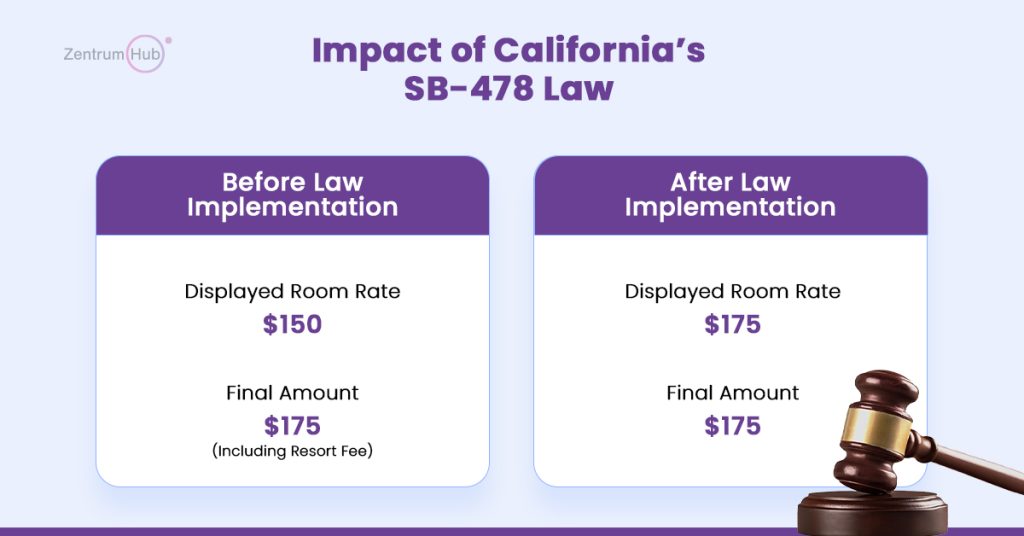
SB 478: California Hotels Faces New Price Transparency Law Overview of SB 478 Implications of SB 478 for the Hotel Industry Benefits to Consumers Conclusion California’s new law, SB 478, known as the “Honest Pricing Law,” aims to eliminate hidden fees and ensure transparent pricing for consumers. Effective from July 1st, 2024, this law mandates that businesses include all mandatory fees in the advertised price of goods and services. This law will have significant implications for various sectors, including the hotel industry. This blog delves into how the hotels sector can navigate these new requirements, ensuring compliance while maintaining consumer trust. Overview of SB 478 SB 478 addresses consumer complaints about hidden fees, such as service fees, resort fees, and other additional charges that are often revealed only at the final stages of a transaction. The law mandates that the advertised price must include all unavoidable fees, promoting transparency and fairness in pricing. However, it exempts government-imposed taxes, shipping costs, and certain behavior-based fees, such as penalties for smoking in non-smoking hotel rooms. Implications of SB 478 for the Hotel Industry The hotel industry often employs various fees that can significantly increase the final cost to the consumer. The introduction of SB 478 necessitates a fundamental change in how these businesses present their pricing to customers. Transparent Advertising Hotels businesses must ensure that all mandatory fees are included in the advertised prices. This means that resort fees, service fees, and any other compulsory charges must be incorporated into the initial price shown to the consumer. For example, a hotel that previously advertised a room rate of $150 per night with an additional $25 resort fee must now advertise the room as $175 per night. Enhanced Consumer Trust One of the primary benefits of SB 478 is the potential for increased consumer trust. When customers see an all-inclusive price upfront, it reduces the likelihood of unpleasant surprises during the booking process. This transparency can enhance customer satisfaction and foster loyalty, as guests appreciate the honesty and clarity in pricing. Challenges in Implementation of SB 478 Implementing these changes will not be without challenges. Californian hotels must review and update their pricing structures, marketing materials, and booking systems to ensure compliance. This might involve: Revising Online Booking Platforms: Ensuring that all fees are clearly displayed in the advertised price on websites and third-party booking platforms. Training Staff: Educating employees about the new requirements and how to communicate them to guests. Legal and Compliance Adjustments: Working with legal teams to ensure that all advertising and promotional materials meet the new standards. Best Practices for Compliance To comply with SB 478, Californian hotels can adopt several best practices: Clear Price Listings: Ensure that all advertised prices include mandatory fees. This transparency should extend across all marketing channels, including websites, social media, and print materials. Detailed Breakdown: While the total price must be clear, providing a detailed breakdown of the cost can help consumers understand what they are paying for. This can include a clear itemization of room rates, resort fees, service charges, and any applicable taxes. Consistent Communication: Ensure all communication channels, including customer service, align with the new pricing transparency. Consistent messaging helps avoid confusion and builds trust. Benefits to Consumers The primary goal of SB 478 is to protect consumers from deceptive pricing practices. By enforcing transparent pricing, the law empowers consumers to make informed decisions. They can compare prices accurately, knowing that the advertised price reflects the total cost they will pay. This not only enhances their shopping experience but also promotes fairness and competitiveness in the market. Conclusion California’s SB 478 represents a significant step towards greater pricing transparency in the hotel industry. By eliminating hidden fees and ensuring that the advertised price reflects the total cost, the law aims to protect consumers and promote fair competition. While the transition to compliance may pose challenges for businesses, the potential benefits in terms of increased consumer trust and satisfaction are substantial. Hotel businesses that embrace these changes and commit to transparent pricing will likely find themselves rewarded with loyal customers who value honesty and clarity. In summary, SB 478 is not just a regulatory requirement but an opportunity for the hotel industry to enhance its relationship with consumers, ultimately leading to a more trustworthy and competitive market. Recommended reads for You The Role of AI in the Hospitality Industry: 2024 Trends How Payment Fraud Occurs in the Hotel Industry? SB 478: California Hotels Faces New Price Transparency Law
How Slow Booking Systems Ruin Online Travel Agencies?
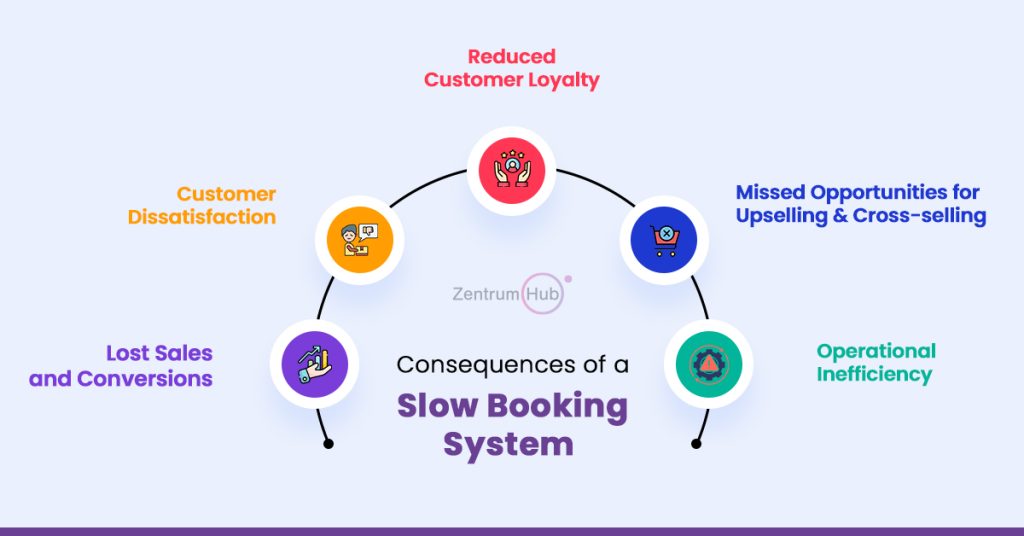
How Slow Booking System Can Ruin Online Travel Agencies? Overview Consequences of a Slow Booking System Impactful Solutions for Slow Booking System Conclusion Imagine a customer brimming with wanderlust, ready to book their dream vacation. They land on your OTA’s website, eager to secure that perfect flight and hotel combo. But then, the wait begins. The page takes ages to load, the search results trickle in, and finally, when they reach the checkout stage, the system grinds to a halt. Frustration sets in, and before you know it, your potential customer has vanished into the digital abyss, likely to a competitor with a smoother booking experience. This scenario, unfortunately, isn’t just a hypothetical nightmare. Slow booking systems can have a significant negative impact on OTAs in several ways. This blog aims to find out the solutions of such many problems that can cause your OTAs to perform poorly. Consequences of a Slow Booking System As an OTA it is necessary to have a responsive and quick booking system; however, on the flipside there are several consequences that one can face. Let’s have a look at it. Lost Sales and Conversions: Impatient travelers won’t wait around for a slow system to catch up. Studies show that website loading speed directly affects conversion rates. A study by Unbounce found that a one-second delay in page load time can result in a 7% decrease in conversions. In the competitive world of OTAs, that 7% can translate into a significant loss of revenue. Customer Dissatisfaction: A slow booking system creates a frustrating user experience. Imagine spending time comparing flights and hotels, only to be met with lag and delays at the crucial checkout stage. This frustration can damage customer perception of your brand and lead to negative reviews, further deterring potential customers. Reduced Customer Loyalty: In today’s travel landscape, convenience reigns supreme. Travelers expect a seamless booking process, and a slow system disrupts this expectation. This can lead to customers abandoning your OTA altogether and seeking out competitors with faster, more user-friendly booking experiences. Missed Opportunities for Upselling and Cross-selling: Slow booking systems can hinder your ability to upsell and cross-sell additional travel products and services. If the checkout process is cumbersome, customers are less likely to consider adding activities, travel insurance, or other travel essentials to their booking. Operational Inefficiency: A slow booking system can create inefficiencies for your own staff. Time spent troubleshooting technical issues or manually processing bookings translates into lost time and resources that could be better spent on customer service or marketing initiatives. Impactful Solutions for Slow Booking System What can OTAs do to combat the negative impacts of slow booking systems? Here are some key strategies: Invest in System Upgrades: Modern, cloud-based booking systems are designed for speed and scalability. Upgrading your existing system or migrating to a new one can significantly improve processing times and ensure a smooth booking experience for your customers. Optimize Your Website: Beyond the booking system itself, website optimization plays a crucial role. Implement techniques like image compression, code minification, and content delivery networks (CDNs) to ensure fast page loading speeds. Prioritize Mobile Friendliness: With the rise of mobile travel booking, a user-friendly mobile experience is essential. Ensure your booking system is optimized for mobile devices and offers a seamless experience across all platforms. Streamline the Booking Process: Analyze your booking process and identify any unnecessary steps that can be eliminated. The fewer clicks and form fields a customer needs to navigate, the faster and more efficient the booking experience will be. Focus on User Experience: Regularly test your booking system and gather user feedback. Identify any pain points that cause delays or frustration and prioritize improvements in those areas. Remember, a user-friendly booking system is an investment, not just a technical hurdle. Transparency is Key: If there are unavoidable delays or system maintenance periods, be upfront with your customers. Communicate these issues clearly on your website and social media channels to manage expectations and prevent unnecessary frustration. Conclusion In conclusion, slow booking systems are a big no-no for OTAs in today’s competitive travel market. By investing in system upgrades, optimizing website performance, and prioritizing user experience, OTAs can ensure a smooth and efficient booking process that keeps customers happy and conversions high. Remember, in the age of instant gratification, speed is not just a convenience – it’s a necessity for success in the online travel industry. So, don’t let a sluggish booking system clip your wings. Act today and create a booking experience that keeps your customers coming back for more. Read more useful blogs for Travel Agencies (OTAs) How Slow Booking System Can Ruin Online Travel Agencies? Why Traditional Hotel Booking Methods Are Costing You Time and Money? Should OTAs Prefer In-House VS Outsourcing Tech Solutions How to Choose Payment Gateways for OTAs? 8 Factors to Consider Before Choosing the Right Hotel Supplier for OTAs How Can B2B Hotel Booking Portal Save Your OTA Business Time & Money? 4 Data Analytics for OTAs to Improve Customer Experience and Business Operations FAQ’s: How Slow Booking System Can Ruin Online Travel Agencies? How does a slow booking system affect my OTA’s revenue? A slow booking system can lead to lost sales and conversions, as impatient travelers are likely to abandon their booking and seek faster alternatives. Studies show that even a one-second delay in page load time can result in a 7% decrease in conversions, significantly impacting your revenue. What are the key strategies to improve my OTAs booking system speed? To enhance booking system speed, invest in system upgrades such as modern, cloud-based solutions. Additionally, optimize your website through techniques like image compression, code minification, and content delivery networks (CDNs). Streamlining the booking process and focusing on mobile friendliness are also crucial. How can a slow booking system affect customer satisfaction and loyalty? A slow booking system frustrates users, leading to a negative experience. This can damage your brand’s perception, result in negative reviews, and decrease customer loyalty. Travelers expect a seamless experience,
Why Traditional Hotel Booking Methods Are Costing You Time and Money?
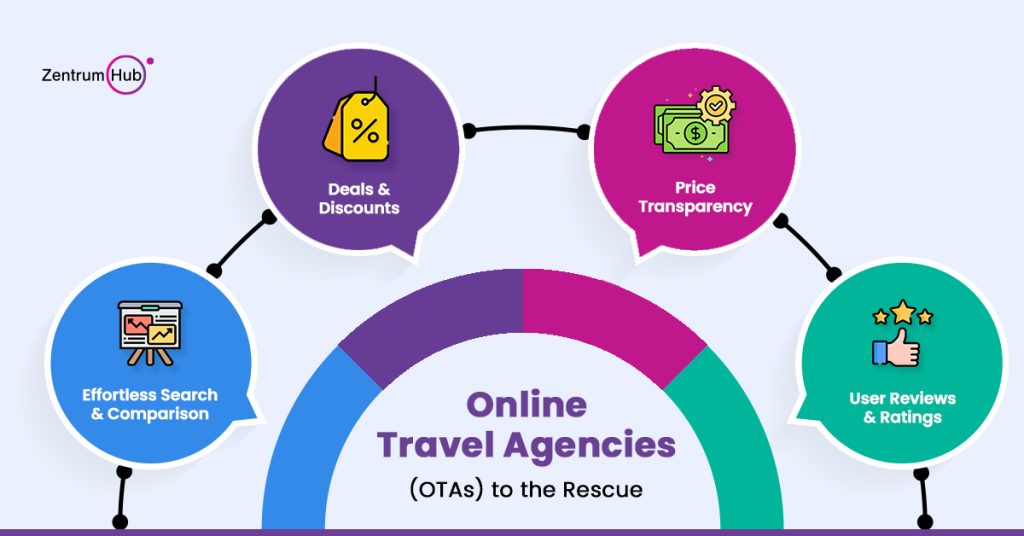
Why Traditional Hotel Booking Methods Are Costing You Time and Money? Overview The Problems with Traditional Booking Stepping into the Future: Online Travel Agencies (OTAs) Beyond OTAs: Supplier Connectivity for Inventory Optimization Conclusion Planning a trip is an exhilarating experience, filled with anticipation for new adventures and discoveries. However, amidst the excitement lies the often-daunting task of finding the perfect hotel. Traditional booking methods, once the norm, now seem outdated and inefficient in today’s fast-paced world. Let’s delve into the reasons why sticking to these old-fashioned methods can ultimately cost you both valuable time and hard-earned money. The Problems with Traditional Booking 1) The Slow Approach Picture yourself spending hours on the phone, dialing one hotel after another, in a painstaking effort to compare rates and amenities. Traditional booking systems demand a significant investment of time and energy, leaving you feeling frustrated and drained. In an era where convenience is paramount, this slow and laborious approach is simply unsustainable. 2) Limited Options Traditional methods often limit your choices to brochures or individual hotel websites, offering only a glimpse of what’s available. This narrow scope means you’re potentially missing out on a vast selection of accommodations that could better suit your needs and preferences. With such limited options, finding the perfect hotel becomes a daunting challenge rather than an exciting part of trip planning. 3) Price Transparency Issues Negotiating rates over the phone can be a stressful ordeal, fraught with uncertainty. Traditional booking systems often lack transparency in pricing, leaving you unsure whether you’re truly getting the best deal. Hidden fees and undisclosed charges further muddy the waters, making it difficult to budget accurately for your trip. 4) Hidden Fees One of the most insidious pitfalls of the traditional booking system is the prevalence of hidden fees. These unexpected charges, often buried in the fine print or only revealed at checkout, can significantly inflate the final cost of your stay. From resort fees to mandatory service charges, these hidden fees can catch even the most seasoned travelers off guard, turning what seemed like a good deal into a costly mistake. Stepping into the Future: Online Travel Agencies (OTAs) Thankfully, the landscape of travel booking has undergone a dramatic transformation with the rise of online travel agencies (OTAs). These digital platforms offer a convenient one-stop solution for booking hotels, flights, and even rental cars, revolutionizing the way we plan and experience travel. Let’s explore how OTAs can help you save both time and money: 1) Effortless Search & Comparison Gone are the days of endless phone calls and tedious comparisons. With just a few clicks, you can effortlessly compare rates and amenities across a vast selection of hotels, putting you firmly in control of your booking process. OTAs streamline the entire experience, allowing you to find the perfect hotel with minimal effort and maximum efficiency. 2) Deals & Discounts One of the biggest advantages of OTAs is their ability to negotiate bulk rates with hotels, translating into significant savings for you, the traveler. Whether it’s last-minute deals or exclusive discounts, OTAs offer a wider range of options compared to traditional booking system, ensuring you always get the best value for your money. 3) Price Transparency Say goodbye to hidden surprises and unexpected fees. OTAs provide all-inclusive pricing with clear breakdowns of taxes and fees, ensuring complete transparency in your booking process. With no hidden costs to worry about, you can book with confidence, knowing exactly what you’re paying for upfront. 4) User Reviews & Ratings Harnessing the collective wisdom of fellow travelers, OTAs feature guest reviews and ratings that offer valuable insights into the quality and experience of each hotel. Whether it’s glowing recommendations or cautionary tales, these user-generated reviews empower you to make informed decisions, ensuring a memorable and enjoyable stay. Beyond OTAs: Supplier Connectivity for Inventory Optimization As the travel industry continues to evolve, a concept gaining traction is supplier connectivity, which allows hotels to directly synchronize their inventory management systems with OTAs. This groundbreaking innovation offers several key benefits: 1) Real-time Availability No more disappointment over false promises of room availability. Supplier connectivity ensures that hotel inventory is constantly updated in real-time, eliminating the frustration of discovering that a room is unavailable after what seemed like a confirmed booking. With accurate and up-to-date information at your fingertips, you can book with confidence, knowing that your chosen hotel is ready to welcome you. 2) Wider Selection of Properties Smaller, independent hotels can leverage supplier connectivity to reach a wider audience through OTAs, leveling the playing field and increasing your options as a traveler. With a diverse range of properties to choose from, you can explore unique and off-the-beaten-path accommodations that may have previously flown under the radar. Conclusion In conclusion, traditional hotel booking methods are a relic of the past, incapable of meeting the demands of today’s modern traveler. By embracing the convenience and efficiency of OTAs, coupled with advancements like supplier connectivity, you can save valuable time and money while ensuring a seamless and stress-free booking experience. So why waste another minute on outdated methods? Embrace the future of travel booking and unlock a world of possibilities at your fingertips. Read more useful blogs for Travel Agencies (OTAs) How Slow Booking System Can Ruin Online Travel Agencies? Why Traditional Hotel Booking Methods Are Costing You Time and Money? Should OTAs Prefer In-House VS Outsourcing Tech Solutions How to Choose Payment Gateways for OTAs? 8 Factors to Consider Before Choosing the Right Hotel Supplier for OTAs How Can B2B Hotel Booking Portal Save Your OTA Business Time & Money? 4 Data Analytics for OTAs to Improve Customer Experience and Business Operations FAQ’s: Why Traditional Hotel Booking Methods Are Costing You Time and Money? Are there any downsides to using online travel agencies (OTAs) to book hotels? While OTAs offer numerous advantages, there are a few things to consider. Some budget hotels might not be listed on major OTAs, and you might miss out on special amenities or packages offered
Should OTAs prefer In-House VS Outsourcing Tech Solutions?
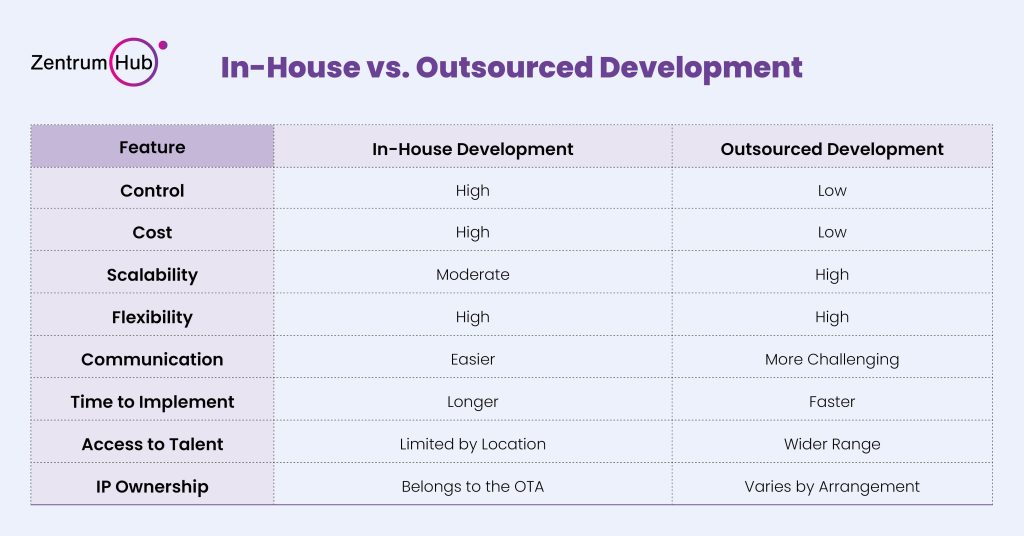
Should OTAs Prefer In-House VS Outsourcing Tech Solutions Overview In-House Development: Building Your Own Tech Team Outsourcing Tech Development:Partnering with Third-Party Vendor Choosing the Right Path: In-House vs. Outsourced Development The Hybrid Approach: Combining In-House and Outsourced Development Conclusion For Online Travel Agencies (OTAs), technology is the lifeblood. It powers everything from search functionalities and booking systems to customer interactions and data analysis. Choosing the right approach to tech solutions, however, can be a complex decision. OTAs must weigh the merits of building an in-house tech team against outsourcing development to a third-party vendor. This blog will explore the advantages and disadvantages of both in-house and outsourced tech solutions, helping OTAs navigate the best path for their specific needs. In-House Development: Building Your Own Tech Team Having an in-house tech team offers OTAs a high degree of control over their technology stack. Here’s a breakdown of the pros and cons: Pros: Direct Control: An in-house team allows for close collaboration between developers and product managers. This fosters a deep understanding of the OTA’s business goals and enables the creation of custom-tailored solutions that perfectly align with those goals. Scalability and Flexibility: In-house teams can be scaled up or down as needed. They can also adapt quickly to changing market demands and technological advancements. Improved Communication and Collaboration: Daily interaction with developers fosters a strong understanding of the project’s vision and facilitates streamlined communication. This can lead to faster development cycles and fewer roadblocks. IP Ownership: Intellectual property (IP) rights for any developed technology remain with the OTA. This can be crucial for OTAs with unique features or functionalities that give them a competitive edge. Cons: High Cost: Building and maintaining an in-house tech team is expensive. It requires not only salaries and benefits for developers but also infrastructure costs for equipment, office space, and software licenses. Time Commitment: Recruiting, training, and managing a qualified in-house team takes considerable time and resources. This can delay project timelines and hinder the OTA’s ability to adapt to rapidly evolving technological landscapes. Talent Pool Limitations: Depending on the OTA’s location, finding and retaining top-tier tech talent can be challenging. This can limit the team’s capabilities and hinder innovation. Risk of Knowledge Silos: In-house teams can become isolated, leading to knowledge silos and a lack of diverse perspectives. Outsourcing Tech Development: Partnering with a Third-Party Vendor Outsourcing tech development involves partnering with a specialized company to handle some or all OTAs technology needs. Here’s a closer look at the pros and cons: Pros: Cost-Effectiveness: Outsourcing is typically cheaper than building and maintaining an in-house team. OTAs pay only for the services they need, eliminating the need for fixed costs associated with salaries, benefits, and infrastructure. Access to Expertise: Outsourcing vendors have access to a pool of experienced developers with diverse skillsets. This allows OTAs to leverage expertise that might not be readily available in-house. Faster Development: Outsourcing vendors often have established development processes and can complete projects more quickly than building an in-house team from scratch. Focus on Core Business: Outsourcing frees up internal resources to focus on core business functions like marketing and customer service. Cons: Loss of Control: OTAs relinquish some control over the development process when outsourcing. Clear communication and a well-defined project scope are essential to ensure the final product meets expectations. Security Concerns: Sharing sensitive data with a third-party vendor can raise security concerns. It’s crucial to choose an outsourcing partner with a strong track record of data security. Communication Challenges: Effective communication can be more challenging with outsourced teams, especially if there are time zone differences or language barriers. Vendor Lock-In: Switching outsourcing vendors can be disruptive and expensive, especially for complex projects. Choosing the Right Path: In-House vs. Outsourced Development The decision between in-house and outsourced development hinges on several factors specific to each OTA. Here are some key considerations: Size and Budget: Larger OTAs with substantial budgets may find in-house development more manageable. Smaller OTAs or those with tighter budgets might benefit more from outsourcing. Project Scope and Complexity: For simple, well-defined projects, outsourcing can be a good option. Complex projects requiring ongoing maintenance might be better suited for an in-house team. Technical Expertise: If the OTA has a strong internal tech team with the necessary skills, in-house development might be the way to go. If expertise is lacking, outsourcing can provide access to the required talent. Speed and Time to Market: For projects requiring a fast turnaround, outsourcing can be advantageous. However, for projects with a longer development timeline, building an in-house team might provide more control. The Hybrid Approach: Combining In-House and Outsourced Development Many OTAs opt for a hybrid approach, leveraging the strengths of both in-house and outsourced development. For example, an OTA might maintain a core in-house team for critical projects and strategic initiatives, while outsourcing non-core functionalities or routine maintenance tasks. This hybrid approach offers flexibility and cost-effectiveness. It allows OTAs to scale their development efforts up or down as needed and access specialized expertise when required. Conclusion There’s no one-size-fits-all answer to the in-house vs. outsourced development question. The optimal approach depends on the unique circumstances of each OTA. By carefully considering the factors mentioned above, OTAs can make an informed decision that aligns with their specific needs and goals. Having a clear understanding of the project’s goals, functionalities, and target audience is essential for success. Open and consistent communication is crucial, especially when working with outsourced vendors. Be realistic about timelines, budgets, and resource requirements. Rigorous testing is essential to ensure the quality and functionality of the developed solution. By carefully evaluating their needs and implementing best practices, OTAs can leverage technology to achieve their business objectives and gain a competitive edge in the ever-evolving travel industry. Read more useful blogs for Travel Agencies (OTAs) How Slow Booking System Can Ruin Online Travel Agencies? Why Traditional Hotel Booking Methods Are Costing You Time and Money? Should OTAs Prefer In-House VS Outsourcing Tech Solutions How to Choose Payment Gateways
Step-by-Step Guide – Go Live with ZentrumHub
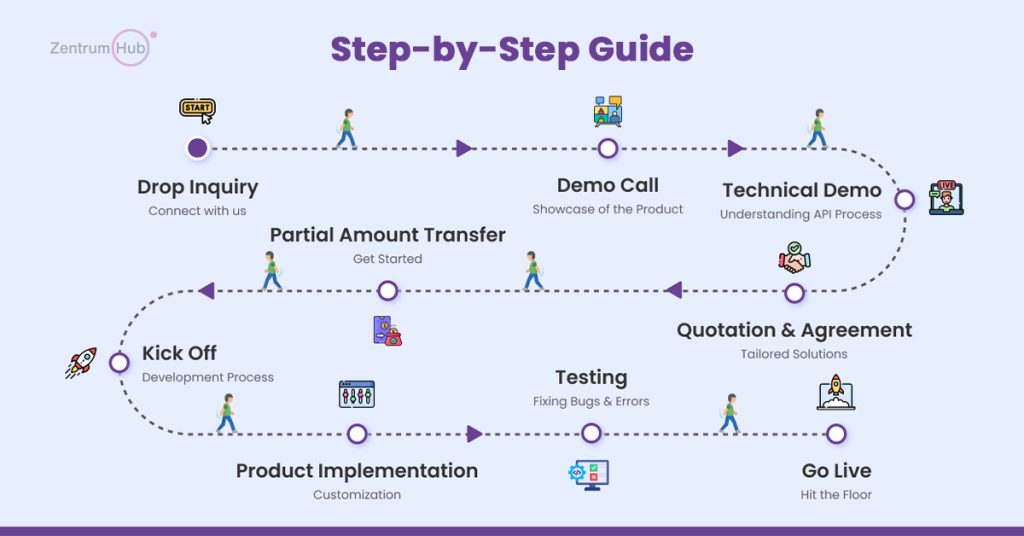
Step-by-Step Guide – Go Live with ZentrumHub Overview Going Live with ZentrumHub API Customers: Your Path to Integration White-Label Customers: Custom Solutions for Your Brand Conclusion Whether you’re an API customer looking for seamless integration or a white-label customer wanting a fully customized solution, our process is designed to ensure a smooth and efficient transition from initial demo to full launch. Let’s walk through the steps together and explore how ZentrumHub can transform your booking operations and enhance your customer experience. Going Live with ZentrumHub 1. Schedule a Live Demo The first step on your journey with ZentrumHub is scheduling a live demo. Our team will walk you through the features and capabilities of our hotel booking engine and API product, demonstrating how it can revolutionize your booking processes and enhance your customer experience. This is your opportunity to ask questions and see the system in action. 2. Define Scope & Contract Signing Once you’ve seen what ZentrumHub can do, the next step is to define the scope of your project. This involves understanding your specific requirements, the features you need, and the customizations you want. Our team will work closely with you to outline the details, ensuring that our solution meets your exact needs. With the scope defined, we move on to contract signing. This formalizes our partnership and sets the stage for the onboarding process. We’ll ensure all terms are clear and mutually agreed upon, paving the way for a successful collaboration. 3. Onboarding Onboarding is where we lay the groundwork for your go-live journey. Our dedicated team will guide you through the initial setup, providing the necessary resources and support to get you started. We make sure you have everything you need to move forward confidently. API Customers: Your Path to Integration For our API customers, we have tailored the process to ensure seamless integration with your existing systems. Here’s how it works: 1. API Overview As an API customer, you’ll first receive a comprehensive overview of our API. Our team will provide detailed documentation and support to help you understand the capabilities and functionalities of the ZentrumHub API. We are here to assist you every step of the way, ensuring you have the knowledge and resources needed for successful integration. 2. Integration Phase & Checkpoints Next, it’s time for your team to integrate the ZentrumHub API into your systems. Our documentation will guide you through the process, and our support team will be available to assist with any challenges you may encounter periodically. This step involves connecting your systems to the ZentrumHub API, ensuring that data flows smoothly and efficiently. 3. Certification – ZentrumHub Once the integration is complete, ZentrumHub will conduct a thorough certification process. This involves rigorous testing to ensure that the integration meets our high standards for performance, security, and reliability. Our certification process guarantees that everything is functioning correctly and that your systems are ready for the final step. 4. Live Credentials Setup and Go Live After successful certification, we will set up your live credentials. This final step transitions your systems from the sandbox environment to the live production environment. With live credentials in place, you are ready to go live! Your customers will now have access to a seamless and efficient booking experience powered by ZentrumHub’s robust hotel booking engine. White-Label Customers: Custom Solutions for Your Brand For our white-label customers, we offer a personalized approach to create a solution that perfectly aligns with your brand. Here’s how we do it: 1. Requirements Gathering We begin by thoroughly gathering your requirements. Our team will work closely with you to understand your specific needs, preferences, and objectives. This step ensures that we have a clear understanding of your vision and the features you want in your custom white-label solution. 2. Customizations as per Product Definitions and Requirements Based on the gathered requirements, we proceed with customizing the white-label solution to match your brand’s identity. This involves tailoring the look and feel of the booking engine, as well as configuring functionalities to meet your specific product definitions and requirements. Our goal is to create a solution that is both visually appealing and functionally robust. 3. Verification Once the customizations are complete, we move on to the verification phase. This involves rigorous testing and quality checks by both ZentrumHub and your team. We ensure that the white-label solution meets all performance, security, and usability standards. This step guarantees that the product is flawless and ready for your customers. 4. Go Live With successful verification, your custom white-label solution is ready to go live. We will assist you with the final steps of the launch process, ensuring a smooth transition and providing support as you begin offering a top-notch booking experience to your customers. Conclusion At ZentrumHub, we’re committed to making your go-live process as smooth and efficient as possible. Whether you’re an API customer integrating our powerful booking engine into your systems, or a white-label customer looking for a custom solution, our team is here to support you every step of the way. Schedule your live demo today and take the first step towards revolutionizing your hotel booking process with ZentrumHub! Read more blogs on Booking Engine Step-by-Step Guide – Go Live with ZentrumHub Know all about Hotel Booking Engine, Functionality, Cost, Types, and Ways to Build Ideal Features that a Hotel Booking Engine Must Have Why Must Every Travel Business Invest in Online Booking Engine?

